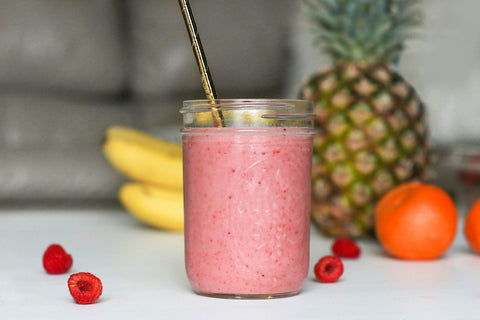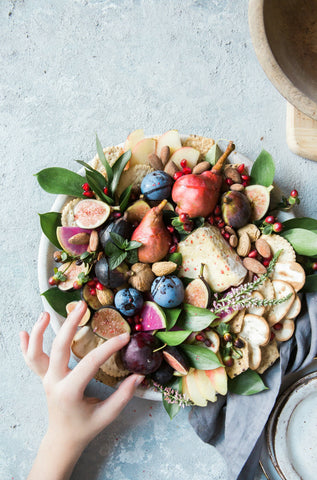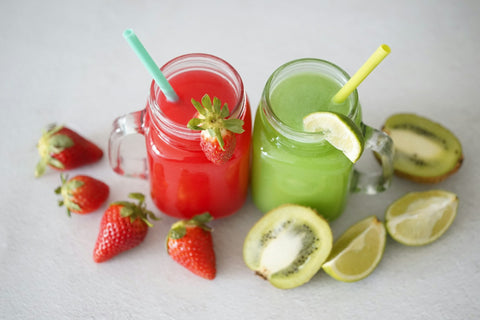Juicing For Beginners: The Ultimate How-To Guide [+ Insider Tips and RECIPES from a Top Juicer Manufacturer]
March 01, 2024
Intro 1: The Expert Approach
We’ve been manufacturing juicers since 1974 and have patents in 50 countries.
All this time and experience has connected us with many people who are new to juicing.
Our clients shared their challenges, such as picking the wrong juicer for their goals or not considering how they’ll scale up their juicing journeys.
That’s why we thought to share our experience in a complete guide to juicing for beginners.
You’ll get a 5-step plan with included recipes, 5 best practices, plus insider tips from our company.
Let’s dive in.
Intro 2: Starting a Juicing Adventure
Welcome to the vibrant world of juicing, where each sip is a step towards vitality and wellness. The path can seem dotted with questions and uncertainties for those just beginning their journey.
This comprehensive guide is your map to simplify the process and enrich your experience.
From understanding the basics of juicing to selecting the right equipment and concocting delightful recipes, we’ll ensure your juicing adventure is enjoyable and transformative.
Let's peel, press, and pour our way to health, armed with insider knowledge and the freshest ingredients.
Intro 3: The Fresh Path to Wellness: A Beginner's Guide to Juicing
Juicing is more than a trend; it's a gateway to a healthier lifestyle, offering a potent infusion of nature's best directly into your daily routine.
For beginners, the world of juicing can seem as complex as it is colorful.
This guide is crafted to demystify the art and science of juicing, bringing together practical advice, expert tips, and mouthwatering recipes.
Whether you're looking to boost your immune system, enhance your energy, or simply enjoy more fruits and vegetables, our how-to guide is the perfect companion to start your juicing journey with confidence and creativity.
What Is Juicing?
Juicing is the process of extracting juice from fresh fruits and vegetables. This method involves grinding, crushing, or squeezing the produce to separate the juice from the pulp, fibers, and seeds. The resulting liquid contains most vitamins, minerals, and plant chemicals (phytonutrients) in the whole fruit or vegetable. As such, juicing helps you maintain a healthy diet by getting all the servings of fruits and vegetables recommended.
Benefits of Juicing
If you’re here, you’re probably already sold on juicing. However, understanding these nutritional benefits and drawbacks will help streamline your juicing experience.
Juicing offers a way to consume a concentrated amount of plant nutrients efficiently.
That's because you get a concentrated source of vitamins, minerals, and antioxidants from raw fruits and vegetables. Besides, juicing allows for easier absorption of nutrients – especially if you drink your homemade juice first thing in the morning on an empty stomach.
That’s why we at Hurom love it.
Side note: One typical complaint against juicing is that, unlike eating whole fruits and vegetables, juice lacks insoluble fiber.
But while this type of fiber is removed during the extraction process, juices still have soluble fiber that benefits the digestive system.
Pro tip: You can also use juices for weight management or detox, but we’ll discuss that in a second.
5-Step Guide to Start Juicing
If you want to reap all those advantages, here’s your easy guide to start juicing as a beginner.
1. Consider Your Needs and Goals
Insider tip: At Hurom, we advise clients to weigh their needs and objectives carefully before they start juicing.
For example, if your juicing plan is to boost your immunity, you may follow recipes that contain fresh ginger. Therefore, you also need a strong enough juicer to squeeze that ginger.
Or, if you love green juice, you need a cold-press juicer that can masticate leafy greens without leaving any wet pulp behind.
Other factors include:
- Space
- Budget
- Whether you’re also interested in making smoothies or other meals
- Ease of use
- Cleanup
- Family size
2. Pick the Right Juicer
There are different types of juicers you can consider.
While at Hurom, we make (arguably the best) cold-press juicers we’ll objectively assess the pros and cons of all your options.
2.1. Cold-Press Juicers (Masticating Juicers)
Cold-press, or masticating juicers, operate by crushing and pressing every bit of fruit and vegetables to extract juice, functioning at lower speeds to minimize heat and oxidation.
Hurom cold-press juicers are especially easy to use for beginners.
We use this technology for our juicers because it preserves more nutrients and enzymes, providing high-quality, nutrient-dense juice. Plus, cold-press juices last much longer in the fridge.
Ideal for leafy greens and fibrous vegetables, cold-press juicers yield more juice with less waste.
Pro tip: Hurom H400 is one of our favorite juicers because it’s compact, easy to clean, and versatile.

Although the juicing process is slower and may require more prep time due to smaller feed chutes, the benefits of richer nutrient content and longer-lasting juice make them a superior choice for health enthusiasts.
PROS: Higher nutritional value, less oxidation, quieter operation, more efficient with leafy greens, longer-lasting juice
CONS: Slower juicing process, higher initial cost.
2.2. Centrifugal Juicers
Centrifugal juicers use a fast-spinning metal blade that spins against a mesh filter, separating juice from flesh via centrifugal force. This method is quick, but the rapid spinning generates heat and introduces air into the juice. Unfortunately, this leads to quicker oxidation and nutrient degradation. Besides, these juicers aren’t as effective for leafy greens and can't match the juice quality or longevity provided by cold-press juicers.
PROS: Fast juicing, affordable
CONS: Lower-quality juice, rapid oxidation, less effective for leafy greens, noisier operation, shorter juice lifespan
2.3. Twin Gear Juicers (Triturating Juicers)
Twin-gear juicers use two interlocking gears to crush and grind produce, extracting a high juice yield. They operate at low speeds, reducing heat and oxidation, similar to our cold-press juicers. This type is excellent for all leafy greens and provides high-quality, nutrient-rich juice. However, they are larger and require more effort to clean and assemble.
PROS: Excellent alternative for green-based juices, quiet, low oxidation, high yield
CONS: More complex to use and clean, larger footprint
2.4. Citrus Juicers
Citrus juicers are designed specifically for juicing fresh citrus fruits like oranges, lemons, and grapefruits. They come in manual and electric variants, offering easy use, quick cleanup, and fresh, flavorful juice. While not versatile for different types of produce, they are an excellent addition if you want to turn citrus juices into a daily habit and don’t like other types of juices.
PROS: Simple to use, efficient for citrus fruits, easy to clean, reasonably priced
CONS: Limited to citrus fruits, not suitable for other types of produce
3. Try Simple Recipes [That Fit Your Goals]
Let’s say you bought your juicer; now, it’s time to try some tasty recipes.
Insider tip: Use a base ingredient high in water so you won’t have to add extra liquids.
Here are some delicious recipes we’ve tried with our juicers. They’re all great for beginners, but we’ll also tell you which health goal they’re best for.
1. Green Goddess Juice: Best for Juice Cleanse
Ingredients: Kale, cucumber, green apple, lemon, ginger
This juice is packed with detoxifying greens and ginger, which promote the removal of toxins and aid digestion. The lemon adds a vitamin C boost, enhancing your detox process.
2. Sunshine Citrus Bliss: Best for Immune Support
Ingredients: Orange, grapefruit, carrots, turmeric
Rich in vitamin C and beta-carotene, this vibrant juice supports your immune system and has anti-inflammatory benefits, thanks to turmeric.
3. Beetroot Boost: Best for Energy
Ingredients: Beetroot, pineapple, mint
Beetroot is known for its ability to improve blood flow and increase stamina, which is why this juice is perfect for an energy boost. Pineapple adds a tropical sweetness, and mint gives it a special tang that complements the earthy beet flavor.
4. Berry Antioxidant Surge: Best for Antioxidant Intake
Ingredients: Blueberries, strawberries, acai berries, watermelon
The delicious fruits in this juice are loaded with antioxidants so that you can fight oxidative stress. Besides, watermelon is rich in vitamins A, B6, and C, which balance your energy levels and heart health.

5. Tropical Digestive Aid: Best for Digestion
Ingredients: Papaya, pineapple, ginger, lime
Papaya contains the digestive enzyme papain, and pineapple has bromelain, both of which aid in breaking down proteins and soothing the stomach. Ginger and lime enhance digestion further.
6. Celery Cleanse: Best for Hydration
Ingredients: Celery, cucumber, green apple, lime
This juice is a hydration hero, with celery and cucumber providing essential electrolytes and water content. Green apple and lime add a refreshing zing and vitamin C.
7. Heart Health Harmony: Best for Heart Health
Ingredients: Pomegranate, red grapes, watercress, flaxseed oil
Pomegranate and red grapes are heart-healthy with potent antioxidants, while watercress adds essential minerals. Flaxseed oil contributes omega-3 fatty acids, supporting cardiovascular wellness. Besides, the flavor combination is amazing.
4. Limit How Many Cups of Juice You Drink Per Day
Beginners tend to quickly fall in love with the beauty of juicing and may go overboard.
Our new clients constantly ask how many cups of juice they can drink per day safely, so we’ve done our research.
The rule of thumb is to limit your daily juice consumption to 8-16 oz of juice.
However, everybody is different, so listen to your body and adjust that intake based on your health needs and hunger cues.
Side note: Juices can serve as a temporary meal replacement during short-term detox or weight loss plans spanning 7 to 14 days. You can drink more juice during such periods, but be mindful of their sugar content.
Some fruits have high sugar levels, so opting for vegetable-based or lower-sugar fruit juices can help you manage your sugar intake. And they’ll also provide essential nutrients during your fasting or juice cleanse.
Insider tip: Pick the right time of day to savor a fresh glass of juice based on these goals:
- In the morning: Best for energy
- During the day: Great before workouts for exercise endurance or as a meal replacement
- In the afternoon: Solid pick-me-up snack that can keep you full until dinner
5. Store Your Juice Correctly
If you don’t store your juice correctly, it will lose its freshness and nutritional value.
We advise our customers to consume fresh juices immediately after juicing to get the most nutrients.
Pro tip: Since Hurom juicers use cold-press technology, juices made with our appliances last up to 72 hours in the freezer without significant nutrient loss.
Other juices may be stored in the refrigerator for up to 24-48 hours.
If you need to store your juice:
- To minimize oxidation, use an airtight container, such as a glass jar with a tight-fitting lid.
- Fill the container to the brim to reduce the air space and, thus, limit oxidation even more.
- Store the juice in the refrigerator.
- Avoid storing juice at room temperature or in clear containers exposed to light because heat and light can accelerate nutrient degradation.
5 Best Practices for Beginner Juicers
The steps above will help you quickly become a juicing enthusiast. But before you get there, here are some of the best practices we recommend to everyone who is new to juicing:
1. Read Your Juicer’s Manual
Familiarize yourself with your juicer's features, maintenance requirements, and safety guidelines. Understanding how to properly assemble, use, and clean your juicer will ensure optimal performance and longevity.
2. Start All Your Juices with a Base
Begin your juice recipes with a high-water-content base to ensure a good yield and smooth consistency. Cucumbers, grapes, and berries are excellent choices because they add volume and help the augers squeeze denser juice ingredients.
3. Balance Fruits, Veggies, Nuts, and Seeds
Create a nutritious blend by including a variety of ingredients. While fresh fruit add strong flavor and sweetness, vegetables offer a wealth of vitamins and minerals. You can also add nuts and seeds in Hurom juicers for a solid intake of healthy fats and proteins. But if you have a lower-quality juicer, you can pre-soak these seeds overnight to make them softer.
4. Reuse the Leftover Pulp
Minimize waste by repurposing the fibrous pulp left after juicing. You can use it in compost or add it to soups, baked goods, or even vegetable broth to avoid squandering its fiber and nutrients.
5. Drink Your Juice Fresh (If Possible)
For the best taste and nutrient retention, we advise you to drink your juice shortly after making it. Fresh juice contains live enzymes and vitamins that begin to degrade over time, so drinking it immediately ensures you get the most health benefits.
How to Kickstart Your Juicing Journey
If you're a juicing novice, this guide gives you all the clarity to get started.
Juicing is a healthy habit, so it's important to stick to it.
Follow the steps above, experiment with various recipes, and reap all the benefits.
But remember to pick the right juicer, so compare appliances in our product line for more ideas. Source
Source